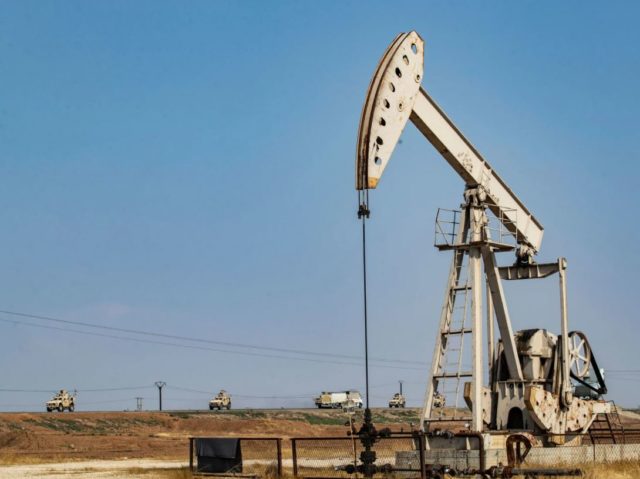
Russia and Syrian Arab Army Targeting Turkish-Backed Opposition’s Energy Infrastructure
Publication: Eurasia Daily Monitor Volume: 18 Issue: 55
By:

The local Russian Aerospace Forces (Vozdushno Kosmicheskikh Sil—VKS) contingent and the Syrian Arab Army (SAA) have shifted their operational focus to targeting energy infrastructure in northwest Syria, including in areas that fall under de facto Turkish control. These offensives have notably involved ballistic missile strikes against oil refineries and tankers along the Ankara-backed opposition-held areas (Anadolu Agency, March 14; Twitter.com/tcsavunma March 15). This new operational pattern could set the stage for an escalatory path in war-torn Syria—a path that even risks turning into an armed collision between Turkey and Russia.
The Russian Federation, and its client, the Baath regime, are pursuing two main strategic objectives by targeting the energy infrastructure in pro-Turkey opposition strongholds. First, reports from the ground indicate that although violence has plagued the country for over a decade at this point, several trade routes linking Syrian refineries with oil tankers had never stopped functioning. This surviving petro-economy has supported thousands of Syrians and kept the prospects of a budding alternative governance in those areas alive (Independent Türkçe, March 22). The Russian military leadership’s plans in Syria seek to restore order and return these territories to status quo ante. Thus, Moscow strives to prevent the sustainability of an alternative politico-economic autonomy in the opposition-held pockets of the country. Second, the threat of sparking refugee waves, especially from Idlib, has long equipped the Kremlin with powerful leverage over Ankara. Simply put, should the local petro-economy wither away in the Turkish-backed regions of northern Syria, Turkey could soon face a renewed influx of masses of Syrian migrants and evacuees seeking entry. Such an outcome would have a broad array of ramifications for the incumbent Turkish administration, ranging from efforts to boost border controls, to more aggressive homeland security policies, to more protectionist domestic political reactions.
Russia and the SAA are likely to carry on their efforts to devastate the opposition-controlled energy facilities in the north. Ankara, having arduously endured the burden of millions of Syrian refugees pouring into every corner of the country since the start of the Syrian conflict, cannot tolerate yet another large wave arriving from its war-torn southern neighbor. If the joint air and missile strikes keep intensifying, then, at some point, this escalatory campaign might force President Recep Tayyip Erdoğan’s administration to react somehow in order to prevent a humanitarian catastrophe with an unbearable strategic cost. At this point, the most critical question revolves around how Turkey could use its military capabilities to address the issue without sparking a head-on conflict with the Russian contingent operating in Syria.
So far, the Turkish Ministry of Defense has carefully drawn a distinctive line between the Syrian Arab Army and the Russian Aerospace Forces when identifying the culprits of the recent strikes. Notably, the Turkish defense ministry has pinned blame specifically on the Baath regime, while avoiding openly confronting Russia for its role (Twitter.com/tcsavunma, March 21). Yet as a signal to Russia, the Turkish Armed Forces hit SAA combat positions in response to their strikes. Some Turkish writings even considered this concept to be a “milestone,” and suggested that Ankara, here on out, would militarily respond to any aggression toward the opposition-governed areas even if Turkish troops were not directly targeted (Twitter.com/tcsavunma, March 14; TRT World, March 17).
The Turkish military enjoys a decisive drone warfare edge (compared to Russia or its Syrian client), married to a robust land-based fire support network deployed along the 2nd Field Army’s area of responsibility. This lethal combination inflicted a heavy blow to Syrian President Bashar al-Assad’s northern buildup in early 2020, during Turkish Operation Spring Shield. Thus, theoretically, the Turkish Armed Forces could bleed the SAA significantly without risking a land incursion into Syria.
However, one should not forget that—as pointed out three years ago by Russia’s chief of the General Staff, General Valery Gerasimov—Russian military advisors have been embedded with nearly all combat units of the SAA (TASS, December 27, 2017). Even though Gerasimov’s assertion of “nearly all units” sounds exaggerated, open-source intelligence does suggest that detachments from some elite Syrian regime units, including the Russia-backed 25th Division (formerly Tiger Forces), deployed along the northwestern frontier, are accompanied by Russian personnel (Twitter.com/GregoryPWaters, March 21). This complicated situation can lead to a yet another dangerous episode between Turkey and Russia in Syria.
When Turkey downed a Russian Su-24 attack jet back in November 2015, the air picture was blurred by the fact that Syrian Arab Air Force and Russian VKS platforms had routinely been flying close to the Turkish border during that period, and the Su-24, in particular, existed in both countries’ arsenals. Today, Turkish retaliation against SAA units targeting Syrian opposition forces and infrastructure could easily result in Russian collateral casualties, thus once again sending Ankara-Moscow relations into a dangerous tailspin.



